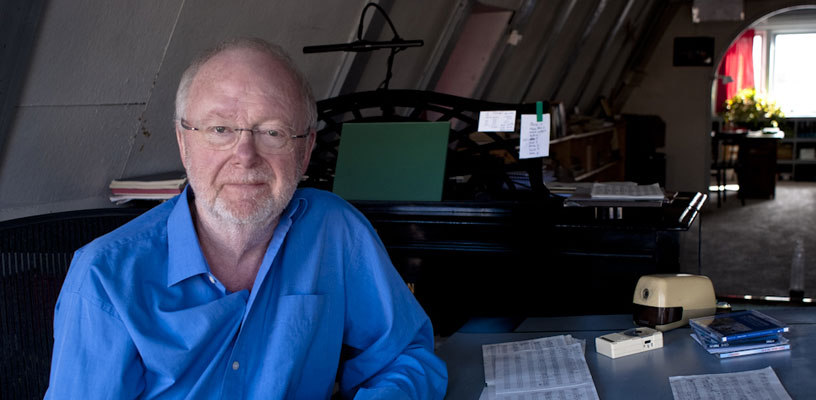Louis Andriessen: Interview about his new Mysteries

Louis Andriessen discusses his new orchestral work, combining spiritual and wordly reflections, premiered by the Royal Concertgebouw Orchestra on 3 November.
Your new orchestral work, Mysteriën, grew from the devotional writings of Thomas a Kempis. How did you first come across his texts?
It was thanks to my father who had a copy of Thomas a Kempis’s The Imitation of Christ. Kempis lived most of his life in a monastery in Zwolle, not far from Utrecht where I grew up, and his writings were important to my father who set them in a number of songs. One in particular I remember hearing in the house as a small child and this has found its way into Mysteriën, at half speed as if a glimpse of a distant memory.
A mystical side to your music, as also heard in Hadewych or De Tijd, offers a complete contrast to your punchy, motoric style. Where do you draw your spiritual roots?
My family upbringing was interesting and unusual in that it combined traditional Catholic principles with a more liberal, artistic world. To illustrate this interface, when my father played an organ improvisation after Mass in Utrecht, many of the believers got up and left, while another crowd of music-lovers arrived at the church to listen. In terms of my own music, the spiritual and serene was always there as a strand, but it had to take a back seat when I was protesting against the classical music establishment, writing for outdoor musicians such as De Volharding – smooth and beautiful music just wouldn’t have worked then.
Do you view the philosophical aspect of Thomas a Kempis as more important than the Christian?
For me, philosophy, mysticism or theatre are all things that stimulate creativity and merge to become rather close – whether their manifestations be Hamlet, Medea or the conception of God. So the ideas in Thomas a Kempis’s book can sit happily alongside not only St Augustine, but also secular writers I’ve drawn upon such as Plato and Lao Tse. I see the six sections of Mysteriën as a sequence of similarly-proportioned frescoes, in a religious setting but depicting worldly scenes even to the point of the painter including the guys who built the church and commissioned the art.
How have you structured Mysteriën?
Each movement is headed by an inscription drawn from Thomas a Kempis’s chapter headings and offers a musical interpretation of the title. The first looks at the vanities of the world, with colliding musical lines illustrating how busy we all think we are. The second examines the misery of mankind with a litany of hocketing broken chords. The third is a central plea for silence exploring “what truth speaks from inside without the noise of words”, while the next reveals the ordeal of a true lover, drawing upon my father’s song. Then a movement pits slow brass against fast strings, reflecting Thomas a Kempis’s perceived contradiction between the natural instinct to do bad things and the God-given gift of grace. The final sixth movement, opening with a sad trumpet lamentation on death, provides something of a cathartic epilogue.
Commissioned for the Royal Concertgebouw Orchestra, does this mean peace has finally broken out? Around 1960 you were protesting against the Concertgebouw’s orchestral programming!
I still have my views on the current cultural-political scene and the repertoire that is programmed, but the time seemed right to compose for the Concertgebouw. Joel Fried, the orchestra’s artistic director, was insistent over three years that he wanted a piece for the 125th anniversary of the hall and the orchestra. I started thinking about the orchestra’s complicated relationship with earlier generations of Dutch composers, including Diepenbrock and Vermeulen as well as my father, and how musical life was controlled by conductors such as Mengelberg. Some years ago a novel by Erik Menkveld appeared about Diepenbrock and Vermeulen titled Im grossen Schweigen (The Grand Silence), named after Diepenbrock’s Nietzsche song setting. This seemed to tie things together for me and offer a way forward. I imagined my father’s voice saying: “Louis, go ahead and write the piece”.
The work employs, surprisingly, a largely traditional symphony orchestra.
Yes, this isn’t my normal ‘terrifying 21st century orchestra’, but the Concertgebouw was flexible saying there was a core of 26 musicians and I could use 8 or 9 extra instruments. This convinced me that I could write a piece aware of the orchestra’s tradition but remaining true to myself. I’ve employed an orchestra with half a string section plus extra colours from soprano sax, low clarinets, three harps – one of which is detuned – two pianos, and plate chimes.
The Concertgebouw concert celebrates the hall’s 125 years, a period that spans from Richard Strauss to your own premiere. How do you as a composer view this orchestral journey?
A lot of the late Romantic repertoire doesn’t grab me. It is only from about 1912 that I reconnect and understand things again. There remain big challenges for orchestras. Some are always the same, such as economic crises and how the state withdraws from the funding of the arts – there isn’t a real difference in that respect between the gangsters of the 1930s and those of today. I hope for a future with adventurous orchestras, not afraid of musical experiments.
Interviewed by David Allenby, 2013
Louis Andriessen
Mysteriën (Mysteries)
for orchestra (2013) 30’
Commissioned by the Royal Concertgebouw Amsterdam for the Royal Concertgebouw Orchestra on the occasion of the 125th anniversary of both hall and orchestra
3 November 2013 (world premiere)
Royal Concertgebouw Orchestra/Mariss Jansons
> Visit the Royal Concertgebouw website
> Further information on Work: Mysteriën
Photo: Francesca Patella
